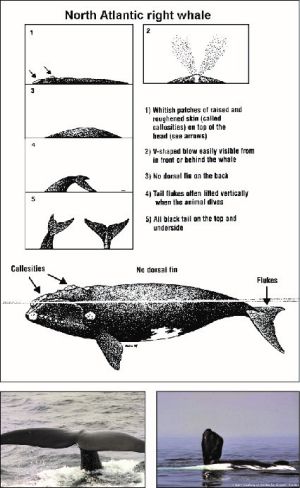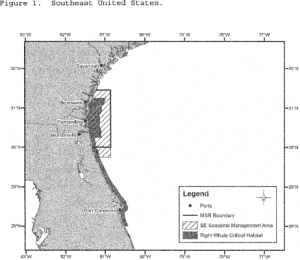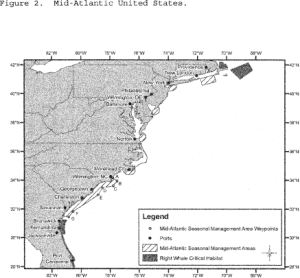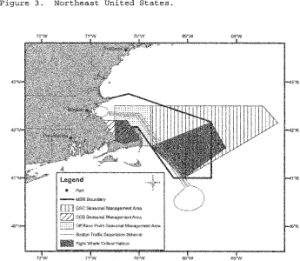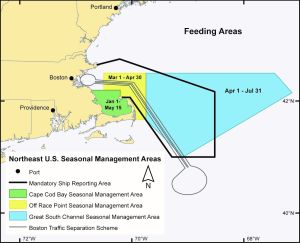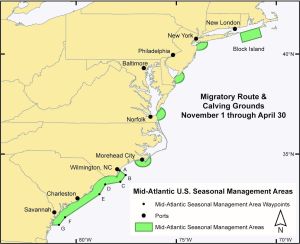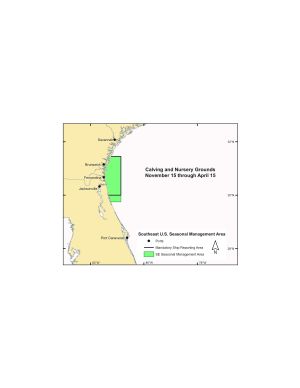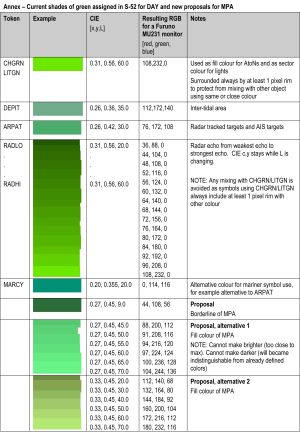S-122
Marine Protected Areas
a place to discuss and follow the work
Knowledgeable WG members: Yves Guillam (IHB)
Portrayal and DCEG: Jens Schröder-Fürstenberg (GE)
NOTE: S-122 will become part of the S-127 (Traffic Management).
Feature Concept Dictionary Terms
| Code | Description | Category |
|---|---|---|
| MPAARE | Marine Protected Area | geographic feature |
| MPADET | Marine Protected Area details | deleted |
| mpapen | Marine Protected Area Penalty | deleted - see Talk:Mpapen |
Sample/Test Data
Discussion of the test data samples
North Atlantic Right Whale Data
NARW test data sample from the test data wiki page is shown below as an inline example for comments within the wiki.
==+=Presence of the North Atlantic Right Whales===+ The North Atlantic right whale is one of the world's most endangered large whale species. North Atlantic right whales are found primarily in continental shelf waters between Florida and Nova Scotia. They migrate annually along the east coast between the feeding grounds off New England and Canada and the calving grounds off Florida, Georgia and South Carolina. Because right whales mate, rest, feed and nurse their young at the surface, and often do not move out of the way of oncoming ships, they are highly vulnerable to being struck. Pregnant females and females with nursing calves appear to be particularly vulnerable to collisions with ships. Ship strikes and fishing gear entanglements are the two known sources of human-related mortality. Intentionally approaching within 500 yards of right whales is prohibited and is a violation of federal law. (See 50 CFR 224.103, chapter 2 for limits, regulations and exceptions.)
Description
Right whales are large baleen whales (Fig. a). Adults are generally 45 to 55 feet in length and can weigh up to 70 tons. The body is mostly black, but irregularly shaped white patches may be present on the ventral surface. The best field identification marks are a broad back with no dorsal fin, irregular bumpy white patches (callosities) on the head, and a distinctive two-column V-shaped blow when viewed from directly behind or in front of the whale. The whales have broad, paddle-shaped flippers and a broad, deeply notched tail. (See following diagrams and photographs.) Right whales are slow moving and seldom travel faster than 5 or 6 knots. They can stay submerged for 10 to 20 minutes and may appear suddenly when surfacing to breathe. They are often seen alone or in small groups. At times, right whales form large courtship groups of 20 to 30 animals.
Seasonal Occurance
During seasons and in areas where right whales may occur, vessel operators should maintain a sharp lookout for whales and reduce speeds when consistent with safe navigation. In any given year oceanographic variability may affect the seasonal distribution of right whales. In 1986, right whales were frequently sighted within the Stellwagen Bank National Marine Sanctuary throughout the summer, and in the early spring of 1998 a large number of right whales were documented near the Narragansett/Buzzards Bay Traffic Separation Scheme. Three areas in U.S. waters have been designated as critical habitats for North Atlantic right whales. The northern critical habitats, the Great South Channel (east of Cape Cod) and Cape Cod Bay extending into Massachusetts Bay, are feeding and nursery grounds. The southern critical habitat, off coastal Florida and Georgia (Sebastian Inlet, Florida to the Altamaha River, Georgia), is a calving area. (See 50 CFR 226.203, chapter 2 for limits, regulations and exceptions).
Seasonal occurrence of North Atlantic right whales
| Location | Season | Comments |
|---|---|---|
| Central Gulf of Maine (Jordan Basin, Cashes Ledge) | April-June October -December |
Editorial: Most of the population can be found in this area during this time |
| Cape Cod Bay | December-May | Editorial: Most of the population can be found in this area during this time |
| Great South Channel, northern edge of Georges Bank | March-July | Editorial: Most of the population can be found in this area during this time |
| Bay of Fundy, Scotian Shelf (Browns Bank, Roseway Basin) | July-October | Most of the population can be found in this area during this time |
| Jeffreys Ledge | October-December | Whales are frequently sighted in this area |
| Stellwagen Bank National Marine Sanctuary | Year-round | Peak sightings occur in the early spring with infrequent sightings in the summer |
| New York to North Carolina | November-April | The migration corridor between right whale habitats is within 30 miles of the Atlantic coast |
| South Carolina, Georgia and Florida calving area | November-April | Calving right whales have been sighted as far north as Cape Fear, NC and as far south as Miami, FL with rare sightings in the Gulf of Mexico |
Speed restrictions
to protect North Atlantic Right Whales
224.105
- The following restrictions apply to: All vessels greater than or equal to 65 ft (19.8 m) in overall length and subject to the jurisdiction of the United States, and all other vessels greater than or equal to 65 ft (19.8 m) in overall length entering or departing a port or place subject to the jurisdiction of the United States. These restrictions shall not apply to U.S. vessels owned or operated by, or under contract to, the Federal Government. This exemption extends to foreign sovereign vessels when they are engaging in joint exercises with the U.S. Department of the Navy. In addition, these restrictions do not apply to law enforcement vessels of a State, or political subdivision thereof, when engaged in law enforcement or search and rescue duties.
- Southeast U.S. (south of St. Augustine, FL to north of Brunswick, GA): Vessels shall travel at a speed of 10 knots or less over ground during the period of November 15 to April 15 each year in the area bounded by the following: Beginning at 31°27'00.0"N, 80°51'36.0"W; thence west to charted mean high water line then south along charted mean high water line and inshore limits of COLREGS limit to a latitude of 29°45'00.0"N thence east to 29°45'00.0"N, 80°51'36.0"W; thence back to starting point. (Fig. 1).
- Mid-Atlantic U.S. (from north of Brunswick, Georgia to Rhode Island): Vessels shall travel 10 knots or less over ground in the period November 1 to April 30 each year:
- In the area bounded by the following: 33°56'42.0"N, 77°31'30.0"W; thence along a NW bearing of 313.26° True to charted mean high water line then south along mean high water line and inshore limits of COLREGS limit to a latitude of 31°27'00.0"N; thence east to 31°27'00.0"N, 80°51'36.0"W; thence to 31°50'00.0"N, 80°33'12.0"W; thence to 32°59'06.0"N, 78°50'18.0"W; thence to 33°28'24.0"N, 78°32'30.0"W; thence to 33°36'30.0"N, 77°47'06.0"W; thence back to starting point.;
- Within a 20-nm (37 km) radius (as measured seaward from COLREGS delineated coast lines and the center point of the port entrance) (Fig. 2) at the
- Ports of New York/New Jersey: 40°29'42.2"N, 73°55'57.6"W;
- Delaware Bay (Ports of Philadelphia and Wilmington): 38°52'27.4"N, 75°01'32.1"W;
- Entrance to the Chesapeake Bay (Ports of Hampton Roads and Baltimore): 37°00'36.9"N, 75°57'50.5"W; and
- Ports of Morehead City and Beaufort, NC: 34°41'32.0"N, 76°40'08.3"W; and
- In Block Island Sound, in the area bounded by the following coordinates: Beginning at 40°51'53.7"N, 70°36'44.9"W; thence to 41°20'14.1"N, 70°49'44.1"W; thence to 41°04'16.7"N, 71°51'21.0"W; thence to 40°35'56.5"N, 71°38'25.1"W; thence back to starting point. (Fig. 2).
- Northeast U.S. (north of Rhode Island):
- In Cape Cod Bay, MA: Vessels shall travel at a speed of 10 knots or less over ground during the period of January 1 to May 15 in Cape Cod Bay, in an area beginning at 42°04'56.5"N, 70°12'00.0"W; thence north to 42°12'00.0"N, 70°12'00.0"W; thence due west to charted mean high water line; thence along charted mean high water within Cape Cod Bay back to beginning point. (Fig. 3).
- Off Race Point: Vessels shall travel at a speed of 10 knots or less over ground during the period of March 1 to April 30 each year in waters bounded by straight lines connecting the following points in the order stated (Fig. 3): 42°30'00.0"N, 69°45'00.0"W; thence to 42°30'00.0"N, 70°30'00.0"W; thence to 42°12'00.0"N, 70°30'00.0"W; thence to 42°12'00.0"N, 70°12'00.0"W; thence to 42°04'56.5"N, 70°12'00.0"W; thence along charted mean high water line and inshore limits of COLREGS limit to a latitude of 41°40'00.0"N; thence due east to 41°41'00.0"N, 69°45'00.0"W; thence back to starting point.
- Great South Channel: Vessels shall travel at a speed of 10 knots or less over ground during the period of April 1 to July 31 each year in all waters bounded by straight lines connecting the following points in the order stated (Fig. 3):
42°30'00.0"N, 69°45'00.0"W
41°40'00.0"N, 69°45'00.0"W
41°00'00.0"N, 69°05'00.0"W
42°09'00.0"N, 67°08'24.0"W
42°30'00.0"N, 67°27'00.0"W
42°30'00.0"N, 69°45'00.0"W
- Except as noted in paragraph (c) of this section, it is unlawful under this section:
- For any vessel subject to the jurisdiction of the United States to violate any speed restriction established in paragraph (a) of this section; or
- For any vessel entering or departing a port or place under the jurisdiction of the United States to violate any speed restriction established in paragraph (a) of this section.
- A vessel may operate at a speed necessary to maintain safe maneuvering speed instead of the required ten knots only if justified because the vessel is in an area where oceanographic, hydrographic and/or meteorological conditions severely restrict the maneuverability of the vessel and the need to operate at such speed is confirmed by the pilot on board or, when a vessel is not carrying a pilot, the master of the vessel. If a deviation from the ten-knot speed limit is necessary, the reasons for the deviation, the speed at which the vessel is operated, the latitude and longitude of the area, and the time and duration of such deviation shall be entered into the logbook of the vessel. The master of the vessel shall attest to the accuracy of the logbook entry by signing and dating it.
- This final rule expires on December 9, 2013.
Mandatory Speed Restrictions
Vessels 65 feet or greater in length overall (L.O.A.) are subject to mandatory speed restrictions of 10 knots or less in seasonal management areas (SMA) along the U.S. East Coast during times when right whales are likely to be present (See following maps for locations of SMAs). The Northeastern SMA speed restrictions are in place from January 1 through May 15 in Cape Cod Bay, from March 1 through April 30 off Race Point, and from April 1 through July 31 in the Great South Channel. Speed restrictions in the Mid-Atlantic U.S. SMAs are in place from November 1 to April 30 and include Block Island Sound, entry into the Ports of New York/New Jersey, Delaware Bay, Entrance to Chesapeake Bay, and the Ports of Morehead City and Beaufort, NC, and within a continuous boundary approximately 20 nautical miles from shore around the major ports of Wilmington, NC, Charleston, SC and Savannah, GA. Speed restrictions are in place in the Southeastern U.S. SMA from November 15 to April 15; this area extends from shore approximately 30 nautical miles eastward and contains the major ports of Brunswick, GA, Fernandina Beach, FL and Jacksonville, FL. (See 50 CFR 224.105, chapter 2 for regulations, limitations, and exceptions and complete description of the SMAs.) NOAA Fisheries may also establish voluntary Dynamic Management Areas (DMAs) when right whales are present in areas and times not covered by the SMAs. Information about established DMAs will be announced over NOAA's customary maritime communication media. Mariners are encouraged to avoid or reduce speeds to 10 knots or less while transiting through DMAs.
Precautions
Precautions when transiting right whale habitat and areas of recently reported right whale sightings:
NOAA recommends the following precautionary measures be taken to avoid adverse interactions with North Atlantic right whales:
Before entering right whale habitat, check Coast Guard Broadcast Notices to Mariners, NAVTEX, NOAA Weather Radio, Mandatory Ship Reporting (MSR) system, Cape Cod Canal Vessel Traffic Control, the Bay of Fundy Vessel Traffic Control, as well as other sources for recent right whale sighting reports. Local ship pilots also have information on whale sightings and safe local operating procedures.
Review right whale identification materials and maintain a sharp watch with lookouts familiar with spotting whales. Although right whales are large, their dark color and lack of a dorsal fin can make them difficult to spot.
Avoid transiting through the right whale habitats and areas where right whales have recently been sighted. If transiting between ports within critical habitats, minimize transit distance. Route around observed or recently reported right whales and anticipate delays due to prudent seamanship in response to whale sightings. Avoid transits at night or during periods of low visibility.
If a right whale is sighted from the ship or reported along the intended track of the ship, mariners should exercise caution, post a lookout and reduce speed to 10 knots when consistent with safe navigation. If a right whale is sighted, a vessel must steer a course away from the right whale and immediately leave the area at slow safe speed. Do not assume right whales will move out of the way of an approaching vessel. Mariners should keep in mind that it is illegal to approach a right whale closer than 500 yards.
Reporting
Reporting details in case of whale struck:
In the event of a strike or sighting of a dead, injured or entangled whale, the following information should be provided:
- location, date, and time of the accident or sighting of a carcass or an entangled whale,
- speed and course of the vessel,
- vessel specifications such as size and propulsion,
- water depth,
- environmental conditions such as visibility, wind speed and direction,
- description of the impact,
- fate of the animal, and
- species and size, if known.
Portrayal
The S-122 Product Specification uses GML for data encoding so it will be possible to portray it in ECDIS systems or used in GML viewer.
What is being done about the portrayal of the text? - briana
GML is a subset of XML...is the plan to encode the text separately from the boundaries or together? - briana
Involvement of Development
The paper submitted to HSSC7-05.5B states a project team should be formed to jointly develop the MPA portrayal specification consisting of:
- The S100WG
- S101SubWG
- The Nautical Chart Working Group (NCWG)
- The NIPWG
- Industry
- members of accredited NGIO
Colors
[CSPCWG11-08.12B Paper to TSMAD24/DIPWG4 discussed the request of suitable shades of green to depict MPAs
Submitted by
Hannu Peiponen / Furuno Finland
Colour palette
DAY colour palette to be worked out before DUSK or NIGHT.
Not a final perfect solution, just something to get started; attempting to find two new basic colour coordinates: one for outline and another for fill.
Work Plan
MPA Portrayal Project Team 2015-2016
| Work | Item | Title Priority H-high M-medium L-low |
Next milestone | Start Date | End Date | Status P-Planned O-Ongoing C-Completed S-Superseded |
Contact Person | Related Pubs / Standard | Remarks |
|---|---|---|---|---|---|---|---|---|---|
| A.1 | Decide on the appropriateness on the portrayal of Marine Protected Area features | H | 2015 | 2016 | P | PT Chair | S-122 | In close liaison with the S-100WG | |
| B.1 | Define the symbols and colour schema for Marine Protected Area features. | H | 2016 | 2016 | P | PT Chair | S-122 | Depends on the A.1 results; Depends on S-100 Test bed availability |
Use Cases
Should list use cases here for planning and underway for both the MPA boundaries and text if applicable. - briana
Behavior
When the MPA layer is selected:
- As a minimum, MPA boundaries should be displayed. The attribute categoryOfRestrictedArea (CATREA in S-57) on the MPA would control whether the boundary will be a pecked line or a T-line. If the attribute is not present the boundary would be pecked. The policy for boundary depiction should follow the principles in S-4.
- If a categoryOfRestrictedArea is defined with the MPA the boundary line should be a T-line.
- If no categoryOfRestrictedArea is defined with the MPA, the boundary line should be pecked.
- A fill should be available but should be switched off in a default view. The fill should be faint; just sufficient to notice. This fill could be turned on when a “Highlight” button in a pick report is selected.
- There should be a centre area/screen label of “MPA”. It is recognised that MPAs overlap with each other and with other area objects in several regions of the world. Existing deconfliction rules should apply to prevent centre labels overlapping.
- The name of the MPA would not be displayed but would be discoverable in a PICREP.
- The colour of all portrayals on the chart display to do with MPAs should be green. It is recognised that MPA boundaries will follow as well as cross coastlines, so a shade, which is distinct from inter tidal green, is required. The advice of CSPCWG/NCWG should specify exactly which shade of green should be used for all purposes.
Recommendations
- CSPCWG/NCWG provides advice which specific colour and colour variances should be used for the MPA portrayal.
- NIPWG (as the replacement of the SNPWG) drafts the portrayal section of the MPA product Specification.
- CSPCWG/NCWG checks the draft and provides feedback.
- Once the portrayal section draft is stable and agreed between NIPWG and CSPCWG/NCWG, the portrayal section of the Product Specification will be completed.
Planned tasks
| Action Item | Actor | Task Description | Start Date | Target End Date | Percent Complete | Task Status |
|---|---|---|---|---|---|---|
| 15/11 | TP+JR | Investigate the possibility of taking the MPA work completed to date and creating a web service as an interim solution. | 40 | Postponed until a stable dataset is available and product specification are established |
Extension Proposal
Marine Pollution - MARPOL - proposed by Transas
